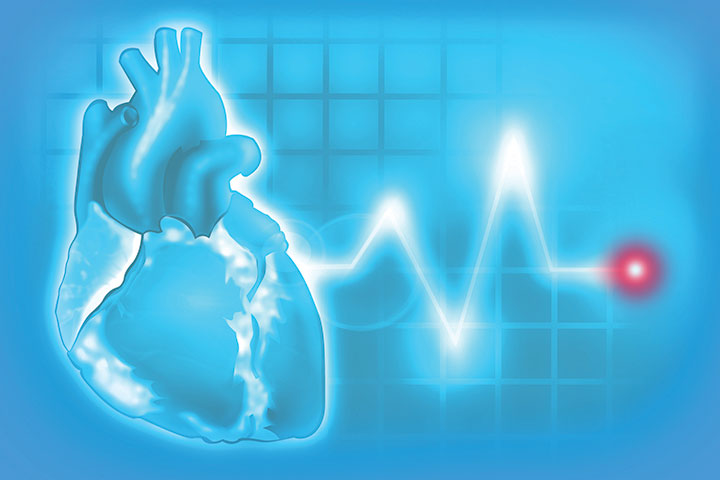Timely intervention saves lives.
Takeaways:
- Nurses can save lives after in-hospital cardiac arrest if skills and knowledge are up-to-date.
- Survival rates after cardiac arrest are slowly improving, with nearly 25% living to hospital discharge and 59% of survivors remaining alive after 1 year.
- Real-time feedback on ventilation and compressions during CPR can prompt refinement of technique and lead to better outcomes.
- Hospitals with protocols for rapid cardiac catheterization and recanalization plus targeted temperature management have better patient survival rates and quality of life at discharge after sudden cardiac arrest.
- BLS and ACLS updates and Joint Commission requirements offer directives for refining delivery of compressions, fine-tuning medications, and standardizing AEDs facility-wide.
By Renee Twibell, PhD, RN, CNE; Austin May, BS, RN; and Parker May, BS, RN
“No pulse! Someone help!”
When these words ring out, healthcare professionals respond immediately. Time is life when the heart stops beating, and interventions must occur within minutes. Across the United States, nurses working in hospitals encounter over 550 patients in sudden cardiac arrest (SCA) each day. The American Heart Association’s (AHA’s) “Get with the guidelines—Resuscitation” data from 2016 show that:
- More than 559,000 people in the United States experience SCA each year inside and outside of hospitals.
- An estimated 325,000 don’t survive.
- In-hospital SCA incidence is more than 200,000 adults and 6,000 children each year.
- Each day, 1,000 Americans die from SCA, about one person every 2 minutes.
- 88% to 95% of SCA victims die before help arrives or before transportation to the hospital.
As first responders and caregivers, nurses can save more lives when their skills and knowledge are up-to-date. Here are some key questions and answers for busy hospital nurses concerned about SCA in hospitalized adults.
What’s SCA?
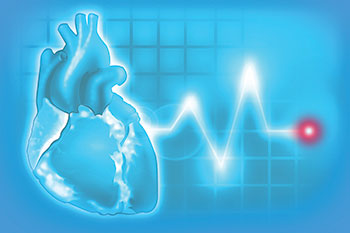

What’s the survival outlook?
SCA survival rates are slowly improving. For individuals who have an in-hospital cardiac arrest (IHCA), the survival rate to discharge is nearly 25%. This is low, but the rate has been trending upward for 15 years. Survival rates can reach 40% when the SCA occurs in a critical care unit. Only 20% of inpatients who arrest on non-critical care units survive to discharge.
The highest risk of death falls within the first 90 days after discharge. For patients who survive to discharge after an IHCA, 59% are alive after 1 year, and only one-third of first-year survivors are readmitted to the hospital for any reason. Survival and readmission rates differ based on patient age, sex, race, and neurologic status at discharge.
Even when patients survive an IHCA, their quality of life—cognitive and functional ability, physiologic stability, return to work or lifestyle, resumption of social and leisure activities, and quality of interpersonal relationships—may be compromised. And they may face a variety of complex medical issues (post-cardiac arrest syndrome) caused by cellular changes from wide-spread ischemia during SCA and subsequent reperfusion from return of circulation. Brain injury, myocardial dysfunction, pulmonary complications, and infections can reduce survival and long-term quality of life. For victims who don’t respond to verbal stimuli after an SCA, tests to predict neurologic outcomes (including electrophysiologic measures, imaging studies, clinical assessment, and blood or cerebrospinal fluid markers of brain injury) can be performed 72 hours after the SCA.
Little research exists on long-term quality of life for victims of IHCA. A few published studies concur that inpatients who survive can achieve an acceptable quality of life, if cognitive function is preserved. Rates of neurologic disability at hospital discharge remain near 50% for survivors of IHCA, and many of these survivors have long-term difficulty with logical thought, memory loss, social engagement, and fatigue. Cognitive deficits are more common among older adults and people who experience coma or delirium post-arrest. Even if physically functional, more than a quarter of survivors and family members may experience post-traumatic stress disorder, anxiety, and depression for months or years.
What’s the financial impact?
The costs of SCA are high for individuals, families, workplaces, and society.
- The estimated annual societal burden of SCA death is between 1.3 and 2 million years of life lost, which is more than the economic burden estimates related to cancer and other morbidities.
- Employers may pay up to 175% of a worker’s annual salary to replace an SCA victim.
- SCA associated with hospitalization can cost from $10,000 to $500,000, depending on the cause and specific interventions required.
Economic impact alone creates a strong impetus for aggressively pursuing new approaches to SCA prevention and timely intervention to increase the chances of optimal quality of life.
What’s new in BLS and ACLS guidelines?
Major revisions to cardiopulmonary resuscitation (CPR) guidelines occurred in 2012, with updates in 2015 and 2017. As a nurse, you can take the lead in implementing recent updates when responding to an IHCA (See BLS updates and ACLS updates). Quickly deliver precise breaths and compressions, along with rapid defibrillation as appropriate, which doubles or triples the chance of survival. For optimal outcomes from CPR, start compressions within 10 seconds of recognizing the arrest. For every minute without CPR and defibrillation, the victim’s chance of survival decreases by 7% to 10%.
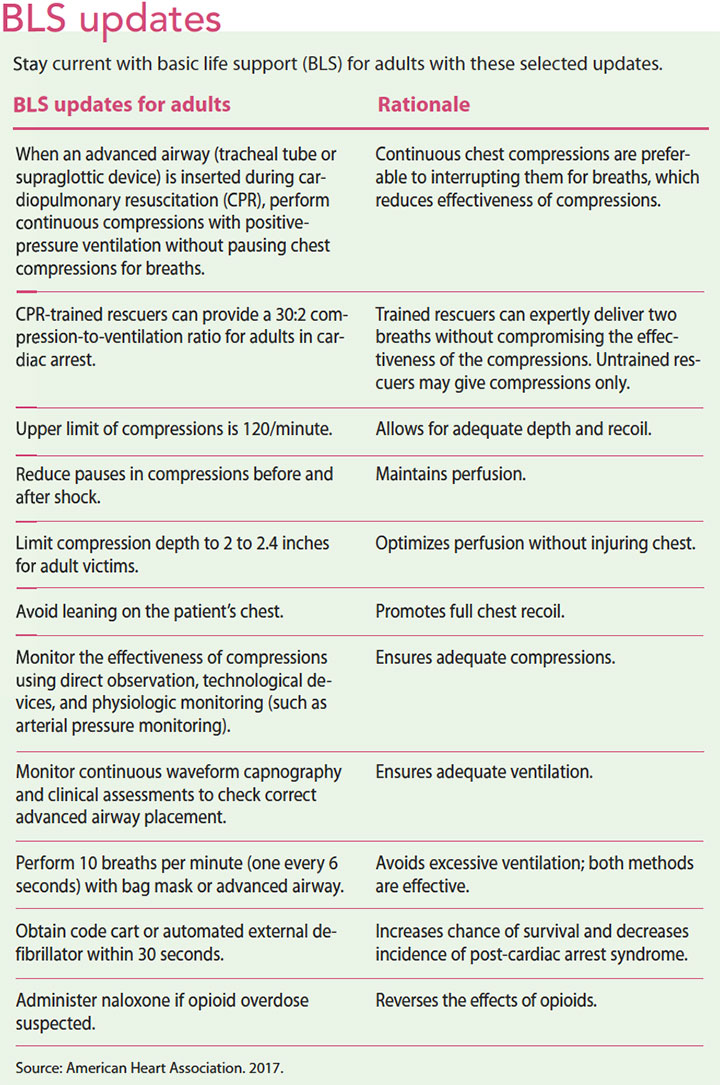

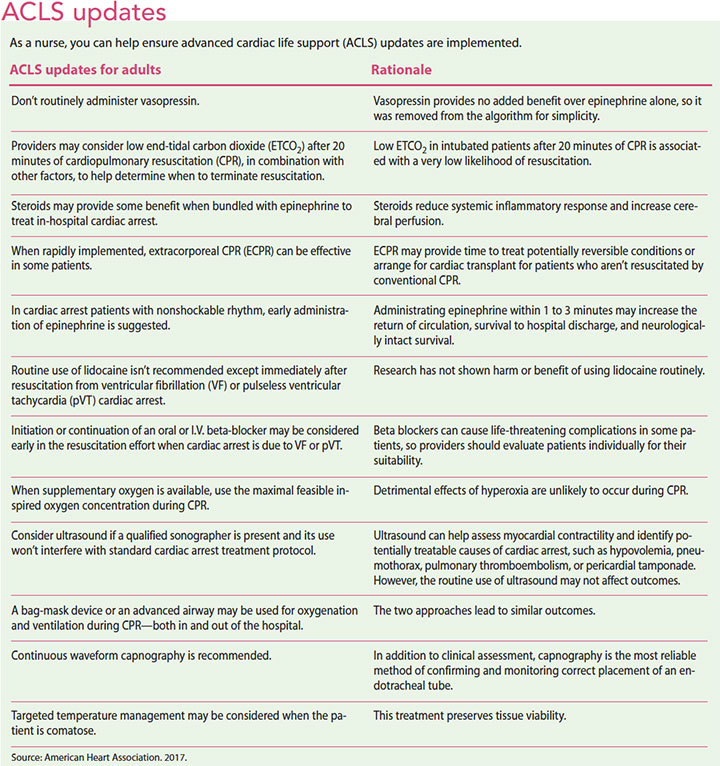

Equally important is skilled communication among team members during a resuscitation event. You can model and coach skilled communication by:
- providing verbal feedback to colleagues on CPR technique in real-time
- ensuring all team members verbally confirm the role they will fill, such as medication nurse or documenter
- speaking respectfully and calmly
- addressing team members by name
- conveying orders clearly and acknowledging orders verbally
- offering periodic verbal summaries of the resuscitation event.
You also can help ensure that these Joint Commission IHCA requirements are addressed:
- on-site presence at all times of an interprofessional emergency response team prepared to implement current ACLS guidelines
- certification in BLS, including how to use an automated external defibrillator (AED), for all hospital staff who care for patients
- standardization of AEDs and resuscitation supply carts across an entire facility so users can easily find supplies and recall how to use the AED
- placement of AEDs for transportation to a patient’s bedside in less than 30 seconds.
In a recent study, education of the emergency response team was identified as a best practice to significantly improve survival of patients who experience an IHCA. Popular training approaches include high-fidelity simulators, simulated mock codes (both announced and unannounced), online practice scenarios, unit-based low-fidelity simulations to focus on selected aspects of resuscitation, and debriefing with all members of the resuscitation team after a mock code, simulation, or live event.
Is earlier detection possible?
Early detection can occur through nursing assessments; however, assessments at specific intervals don’t always catch subtle, trending changes that predict IHCA. Technology can help. For example, you can enter patient data into the electronic medical record or other electronic device, and early-warning systems (EWS) will compare the data to weighted pre-set standards. The EWS then signals when a patient’s data is outside of a predetermined range. Although EWSs weren’t designed specifically for early detection of SCA, they can identify a deteriorating patient by evaluating heart rate, respiratory rate, oxygen saturation, use of supplemental oxygen, temperature, systolic blood pressure, and level of consciousness.
Across a body of research on clinical antecedents of SCA, typical findings 1 to 12 hours before an SCA include elevated respiratory rate, lower mean arterial pressure, lower systolic blood pressure, and elevated heart rate, with secondary findings of low bicarbonate level and elevated central venous pressure. However, not all patients whose data trigger an early alert develop a life-threatening condition, calling into question the cost-effectiveness of these alerts. Over 30 different monitoring systems are available or in testing to detect clinical deterioration early for a range of crisis conditions.
The usefulness of EWSs depends on the accuracy of your assessments and data entry. Some EWSs collect data directly through a continuous monitoring system, which removes any clinician errors.
Some hospitals may elect to continuously monitor all patients to reduce rates of failure to rescue. Continuous monitoring systems improve the likelihood of early detection, ideally through a wireless system to avoid patient complaints of wires and pads. Research has yet to determine the cost–benefit of continuous patient monitoring for large numbers of inpatients and which data points, or constellations of data points, call for crisis intervention in specific patient populations.
An innovative and less expensive alternative for early detection is to have a full-time RN with strong critical care experience who doesn’t take patient assignments but instead rounds on inpatients throughout a hospital or a section of a hospital. (See Rounding nurse in action.) 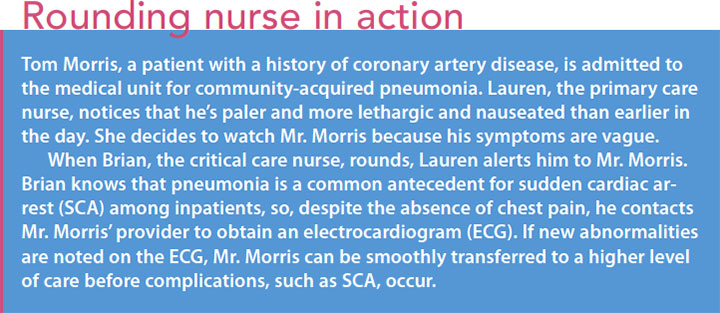

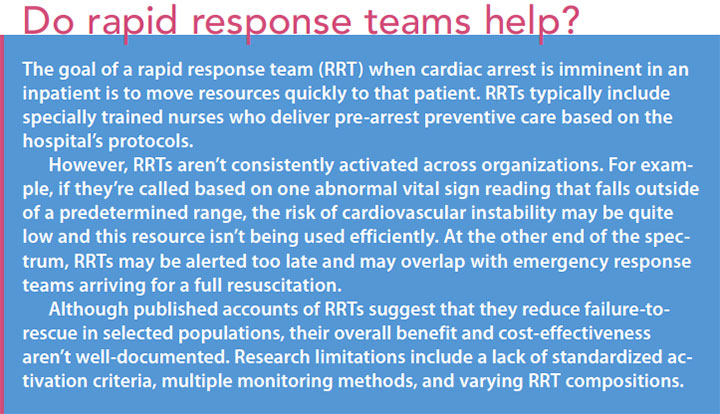

What’s the best post-arrest management?
Survival after the initial return of spontaneous circulation depends on many factors, and post-arrest care is based on the cause of SCA and the pattern of ischemic organ injury. The following interventions may increase the chances of post-arrest survival and good quality
of life.
- Evidence-based practice recommendations include a 12-lead electrocardiogram as soon as spontaneous circulation returns to detect acute ST elevation indicating cardiac injury. Of patients who survive initial resuscitation, over 70% have coronary artery stenosis. When treated with rapid coronary angiography and recanalization, post-arrest survival rates and quality of life increase.
- Medications to stabilize blood pressure are crucial in the immediate post-arrest hours. Maintaining systolic blood pressure above 90 mm Hg improves chances of survival.
- Targeted temperature management (TTM), previously known as induced therapeutic hypothermia, may be effective for post-arrest patients who don’t respond to verbal commands. Lowering body temperature to between 32° C and 36° C (89.6° F and 96.8° F) for 12 to 24 hours may salvage tissue placed at risk by diminished perfusion. Research is still mixed on this intervention, but a cluster of studies show that IHCA victims who qualify for and receive TTM have better outcomes after 6 months.
- Hospitals with protocols for rapid cardiac catheterization and recanalization plus TTM have better patient survival rates and quality of life at discharge after SCA.
- For patients at high risk for ventricular tachycardia or fibrillation, implantable cardioverter defibrillators can rapidly treat the lethal heart rhythm by delivering a shock in less than 1 minute. Wearable cardioverter defibrillators can be a temporary source of monitoring and shocking, as needed.
Is there hope for more improvement?
To improve the quality of CPR, the AHA has mandated that, by January 31, 2019, instrumented directive feedback devices (manikins) will be required in all AHA courses that teach adult CPR. Technological innovations (flashing lights and automated voice feedback) are in development to monitor and provide pointers on ventilation and compressions during CPR. In addition, technique refinement—such as reduced time off compressions, proper compression depth, and excessive ventilation prevention—will lead to better outcomes.
To hasten advances in emergent treatment of IHCA, healthcare professionals need more national-level data from large numbers of inpatients and more analysis of the data to guide quality improvement. The AHA’s “Get with the guidelines—Resuscitation” collects data on IHCA and CPR from hospitals nationwide, creates evidence-based guidelines for inpatient CPR, and provides additional resources and tools for healthcare professionals and laypersons. In the future, the Centers for Disease Control and Prevention may expand the Cardiac Arrest Registry to Enhance Survival to include both in-hospital and out-of-hospital data. This all-inclusive registry would:
- bolster data analysis on the effectiveness of new interventions
- furnish data to clearly identify factors that influence survival
- increase hospitals’ accountability for SCA outcomes
- allow hospitals to accurately calculate their survival rates and predictors
- supply evidence for performance improvement initiatives and tailoring of interventions to individuals and target populations.
Every day, in unannounced tragic intrusions, SCA steals life from patients and those who love them. Through up-to-date knowledge and quick action, nurses can detect EWSs, provide breath and blood flow, and partner with colleagues for post-arrest remedies.
Renee Twibell is a nurse researcher at Indiana University Health Ball Memorial Hospital and an associate professor in the school of nursing at Ball State University, both in Muncie. Austin May is a clinical nurse in the cardiac intensive care unit and Parker May is a clinical nurse in the intensive care unit at Indiana University Health Ball Memorial Hospital, Muncie.
Selected references
American Heart Association. Get with the guidelines®—Resuscitation overview. Updated October 27, 2017.
American Heart Association. Guidelines for CPR & emergency cardiovascular care. Updated November 2017.
American Heart Association. Part 7: Adult advanced cardiovascular life support. In: 2015 American Heart Association (AHA) Guidelines Update for Cardiopulmonary Resuscitation (CPR) and Emergency Cardiovascular Care (ECC). 2015.
American Heart Association. Resuscitation: Fact sheet. May 2017.
American Heart Association. 2017 AHA focused update on adult and pediatric basic life support and CPR quality. November 7, 2017.
Beesems SG, Wittebrood KM, de Haan RJ, Koster RW. Cognitive function and quality of life after successful resuscitation from cardiac arrest. Resuscitation. 2014;85(9):1269-74.
Centers for Disease Control and Prevention. Cardiac Arrest: An Important Public Health Issue.
Chan PS, Berg RA, Tang Y, Curtis LH, Spertus JA, American Heart Association’s Get With the Guidelines–Resuscitation Investigators. Association between therapeutic hypothermia and survival after in-hospital cardiac arrest. JAMA. 2016;316(13):1375-82.
Cronberg T, Lilja G, Horn J, et al. Neurologic function and health-related quality of life in patients following targeted temperature management at 33° C vs 36° C after out-of-hospital cardiac arrest: A randomized clinical trial. JAMA Neurol. 2015;72(6):634-41.
Girotra S, Nallamothu BK, Spertus JA, et al. Trends in survival after in-hospital cardiac arrest. N Engl J Med. 2012;367(20):1912-20.
Girotra S, Spertus JA, Li Y, et al. Survival trends in pediatric in-hospital cardiac arrests: An analysis from Get With the Guidelines—Resuscitation. Circ Cardiovasc Qual Outcomes. 2013;6(1):42-9.
Israelsson J, Bremer A, Axelsson Å, et al. Neurologic outcome, health-related quality of life, anxiety and symptoms of depression among in-hospital cardiac arrest survivors. Resuscitation. 2015;96(suppl 1):101.
Jarvis S, Kovacs C, Briggs J, et al. Aggregate National Early Warning Score (NEWS) values are more important than high scores for a single vital signs parameter for discriminating the risk of adverse outcomes. Resuscitation. 2015;87:75-80.
Jones DA, DeVita MA, Bellomo R. Rapid-response teams. New Engl J Med. 2011;365(2):139-46.
Larsson IM, Wallin E, Rubertsson S, Kristofferzon ML. Health-related quality of life improves during the first six months after cardiac arrest and hypothermia treatment. Resuscitation. 2014;85(2):215-20.
Meaney PA, Bobrow BJ, Mancini ME, et al. CPR Quality: Improving cardiac resuscitation outcomes both inside and outside the hospital: A consensus statement from the American Heart Association. Circulation. 2013;137(2):103-5.
Nielsen N, Wetterslev J, Cronberg T, et al. Targeted temperature management at 33°C versus 36°C after cardiac arrest. N Engl J Med. 2013;369(23):2197-206.
Neumar RW, Shuster M, Callaway CW, et al. Part 1: Executive summary: 2015 American Heart Association guidelines update for cardiopulmonary resuscitation and emergency cardiovascular care. Circulation. 2015;132(18, suppl 2):S315-67.
Rozen TH, Mullane S, Kaufman M, et al. Antecedents to cardiac arrests in a teaching hospital intensive care unit. Resuscitation. 2014;85(3):411-7.
Schemenaur C, Bunch L. Rapid response nurse rounding initiative. Indiana Organization of Nurse Executives Annual Conference. October 2016; French Lick, IN.
Smith GB, Prytherch DR, Meredith P, Schmidt PE, Featherstone PI. The ability of the National Early Warning Score (NEWS) to discriminate patients at risk of early cardiac arrest, unanticipated intensive care unit admission, and death. Resuscitation. 2013;84(4):465-70.
Tirkkonen J, Olkkola KT, Huhtala H, Tenhunen J, Hoppu S. Medical emergency team activation: Performance of conventional dichotomised criteria versus national early warning score. Acta Anaesthesiol Scand. 2014;58(4):411-9.
ant2-Cardiac Arrest-118

